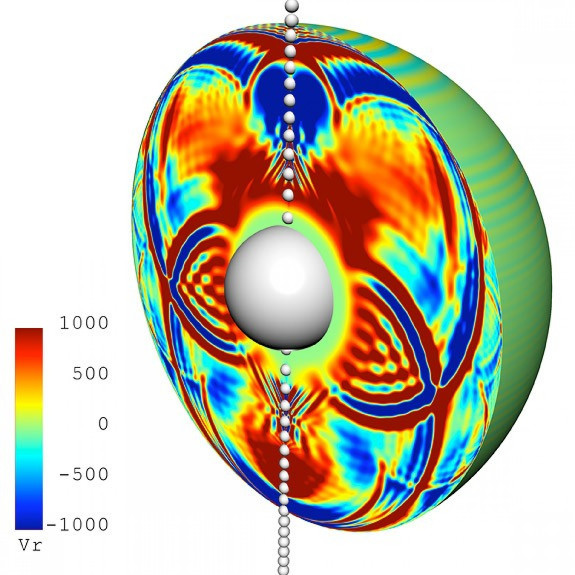Researchers Develop Method for Detecting Black Hole, Star Collision

Researchers at Princeton University and New York University have developed a ready-made method for detecting the collision of stars with an elusive type of black hole that is believe to make up dark matter.
They believe this method will be beneficial to as astronomers who are seeking to capture evidence of dark matter, which is the invisible substance thought to constitute much of the universe.
Postdoctoral researchers Shravan Hanasoge of Princeton's Department of Geosciences along with Michael Kesden of NYU's Center for Cosmology and Particle Physics managed to simulate visible result of a primordial black hole passing through a star.
Thought to be remnants of the Big Bang, primordial black holes are said to possess the properties of dark matter. They are one of various cosmic objects thought to be the source of the mysterious substance, but they have yet to be seen.
And the authors of the report believe that if primordial black holes are the source of dark matter, then the sheer number of stars in the Milky Way galaxy ? roughly 100 billion ? makes such an encounter inevitable.
They say unlike larger black holes, a primordial black hole wouldn't swallow the star. Instead it would cause noticeable vibrations on the star's surface as it passes through.
Hanasoge said as the number of telescopes and satellites that are searching distant stars in the Milky Way increases, so will the chances to see a primordial black hole as it harmlessly passes through one of the galaxy's billions of stars.
If astronomers were just looking at the sun, the chances of observing a primordial black hole are not likely, but people are now looking at thousands of stars, Hanasoge said. There's a larger question of what constitutes dark matter, and if a primordial black hole were found it would fit all the parameters ? they have mass and force so they directly influence other objects in the universe, and they don't interact with light. Identifying one would have profound implications for our understanding of the early universe and dark matter.
The computer model that's developed by Hanasoge and Kesden can be used with current solar-observation techniques to provide a more precise method for detecting primordial black holes than existing tools, according to researchers.
The paper is published in the journal Physical Review Letters.
Ripples can be seen on a star
Although there has been no direct observation of dark matter, scientists believe galaxies are residing in extended dark-matter halos. This is based on documented gravitational effects of these halos on galaxies' visible stars and gas.
Primordial black holes, like other proposed dark-matter candidates, are tough to find because they neither produce nor absorb light, but sneakily navigating the universe with only subtle gravitational effects on nearby objects.
Primordial black holes are heavier than other dark-matter candidates and so their interaction with stars would be visible by existing and future stellar observatories, Kesden said.
When a primordial black hole crosses a star, its gravity would squeeze the star. Once the black hole passes through, the star's surface ripples as it snaps back into place.
If you imagine poking a water balloon and watching the water ripple inside, that's similar to how a star's surface appears, Kesden said. By looking at how a star's surface moves, you can figure out what's going on inside. If a black hole goes through, you can see the surface vibrate.
Using the sun's surface for clues of dark matter
The team of researchers used the sun as a model to calculate the effect of a primordial black hole on a star's surface. They were able to determine the masses of a primordial black hole, the likely trajectory of the object through the sun, and worked out the black hole's vibrational effect on the sun's surface.
Video simulations were created by NASA's Tim Sandstrom using the Pleiades supercomputer at the agency's Ames Research Center in California.
Marc Kamionkowski, a professor of physics and astronomy at Johns Hopkins University, said the research will help as a toolkit for detecting primordial black holes.
It's been known that as a primordial black hole went by a star, it would have an effect, but this is the first time we have calculations that are numerically precise, Kamionkowski said. This is a clever idea that takes advantage of observations and measurements already made by solar physics. It's like someone calling you to say there might be a million dollars under your front doormat. If it turns out to not be true, it cost you nothing to look. In this case, there might be dark matter in the data sets astronomers already have, so why not look?
Kamionkowski said a noteworthy aspect of the new research is that it narrows a significant gap in the mass that can be detected by existing methods of looking for primordial black holes.
The researchers also found through their simulations that a primordial black hole larger than 1 sextillion (21 zeroes) grams, which is roughly the mass of an asteroid, would be able to produce a noticeable effect on a star's surface.
Now that we know primordial black holes can produce detectable vibrations in stars, we could try to look at a larger sample of stars than just our own sun, Kesden said. The Milky Way has 100 billion stars, so about 10,000 detectable events should be happening every year in our galaxy if we just knew where to look.
© Copyright IBTimes 2024. All rights reserved.






















